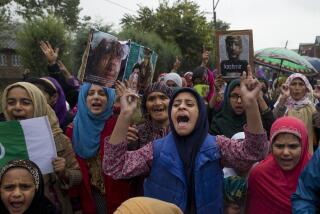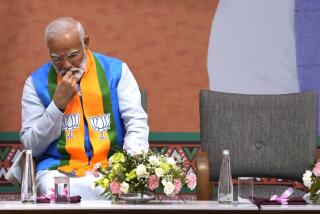India: Between Unity and Disintegration : World’s largest democracy faces election challenges
- Share via
India, the world’s largest democracy, faces a historic challenge next week when voters go to the polls. At stake is a 40-year tradition of secular government, now threatened by long-festering political, economic and religious tensions. Democracy is about the only thing that seems to works well in India. The process miraculously has survived, despite sometimes hapless leadership.
On the eve of three-day national elections that begin on Monday, India treads the fine line between unity and disintegration. Rising Hindu militancy and Sikh and Muslim separatist movements have resulted in formidable challenges to the policies of the Congress Party, the primary architect and arbiter of India’s secular government since it became an independent nation in 1947. The party lost its singular hold on power in 1989 because disillusioned voters, particularly the rural poor, used the ballot process to register their discontent with the status quo.
Political turmoil has roiled India ever since. Three prime ministers have come and gone in just 18 months. Two coalition governments have failed to make any change: The most recent one, headed by former prime minister Chandra Shekhar of the Janata Dal party, lasted a mere 117 days. Now five parties, including the Congress Party led by former Prime Minister Rajiv Gandhi, are vying for seats in Parliament in campaigns marred by violence.
Whatever the outcome of the election, the key to maintaining India’s precious secular tradition is economic reform. Tapping India’s economic potential provides the best promise of alleviating the country’s crushing poverty and stabilizing the religious and social unrest gripping the nation of 844 million.
But that takes political will. India’s burdensome centralized economy must be freed from a crippling, vast and inefficient bureaucracy. Because of its long tradition of colonial exploitation, India shunned the outside trading world and instead allowed itself to be isolated from the global economy.
India may be self-sufficient now, but it has come at a high cost to its people and to progress. Attempts at anemic (though drastic by Indian standards) economic reforms under Gandhi’s rule in the mid-1980s were short-lived. Since then, foreign investment has slowed while debt and inflation have risen sharply.
India’s leadership must abandon its antiquated notions of self-sufficiency, dismantle its burdensome civil service and decentralize and deregulate its economy. Its hard-working people deserve better lives and could build them, given the chance.
It’s less clear that Indian voters see much prospect for any stability emerging from the upcoming elections. India’s destabilized parliamentary system and other mounting political woes mirror the rising tensions between Hindus and Muslims. An organized Hindu presence in the right-wing Bharatiya Janata Party has polarized the Indian political process and led to the splinter parties. Some of the worst religious riots in India’s history erupted last autumn when the militant Hindus threatened to convert a Muslim mosque into a Hindu temple.
Complicating the religious conflicts are hierarchical social caste tensions, which were expected to subside as India modernized. Unfortunately, that hasn’t happened and the poor have become a potent political following heavily courted by politicians. Meanwhile, the unity of the Indian federation of 25 states has come under strain from separatist movements in Punjab, Kashmir and Assam.
Any coalition government composed of such divergent interests is tenuous at best. And fundamental reforms are hard to come by in cooperative governments. So India will be a test of whether reform can be achieved in a unique democracy that must delicately balance secular and religious interests.
More to Read
Sign up for Essential California
The most important California stories and recommendations in your inbox every morning.
You may occasionally receive promotional content from the Los Angeles Times.










